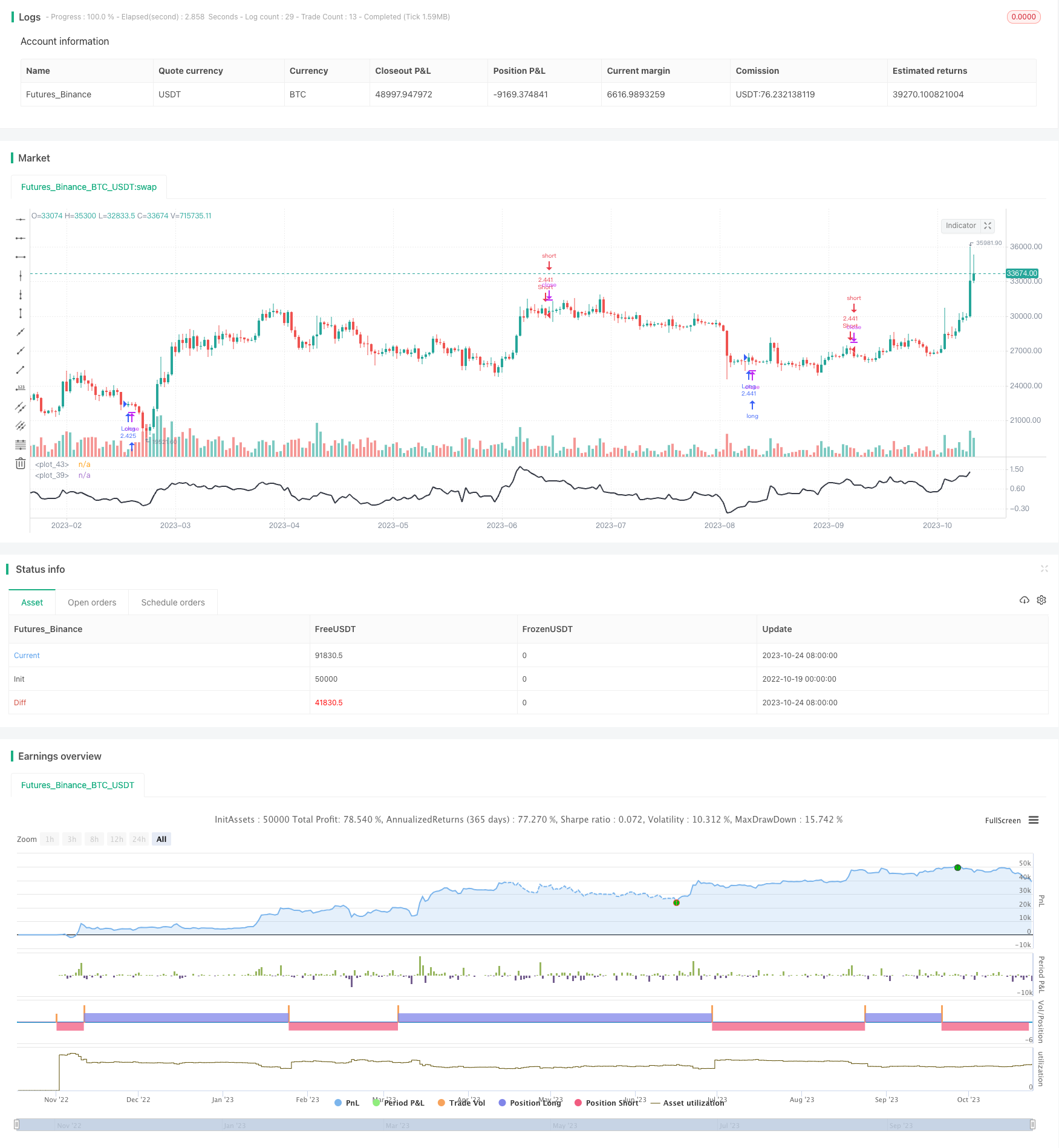
概述
本策略基于RSI指标设计了一个简单的趋势跟随交易系统,可以在特定日期范围内,通过RSI指标判断市场趋势方向,实现自动做多做空。
策略原理
该策略使用RSI指标判断市场趋势,以及布林带通道判断超买超卖区域。
首先,计算RSI值,然后通过RSI的移动平均线及标准差计算出布林带上下轨。RSI指标在0-1之间波动,布林带通过标准差确定超买超卖区间,RSI高于上轨时为超买区,低于下轨时为超卖区。
当RSI从下轨突破到上轨时产生买入信号,从上轨突破到下轨时产生卖出信号,实现趋势跟随。策略进场后,不设置止损止盈,直到指定日期结束时平仓。
该策略简单有效地利用RSI指标判断趋势方向,辅以布林带确定具体的交易时机。通过限定交易日期范围,可以避免不必要的风险。
优势分析
- 使用RSI指标判断趋势方向简单有效
- 结合布林带确认交易信号,避免假突破
- 限定交易日期范围,有助于规避市场风险
- 不设置止损止盈,最大限度跟踪趋势
- 可灵活调整参数,适用于多种市场环境
风险及优化
- 市场可能出现剧烈波动,导致亏损
- 未设置止损止盈,无法有效控制风险
- 参数设置不当可能导致交易频繁或错过机会
优化方向:
- 加入止损止盈策略,控制风险
- 优化参数设置,提高胜率
- 结合其他指标过滤信号,避免假突破
- 动态调整仓位规模
总结
本策略总体来说是一个非常简单直接的趋势跟随策略。使用RSI判断趋势,布林带过滤信号,限定交易日期范围,可以有效跟踪趋势并控制风险。但策略可以进一步优化,在保持简单有效的基础上,通过止损止盈、参数优化、信号过滤等方法进一步完善,使策略更适合实盘交易。
策略源码
/*backtest
start: 2022-10-19 00:00:00
end: 2023-10-25 00:00:00
period: 1d
basePeriod: 1h
exchanges: [{"eid":"Futures_Binance","currency":"BTC_USDT"}]
*/
//Gidra
//2018
//@version=2
strategy(title = "Gidra's RSI or MFI Strategy v0.1", shorttitle = "Gidra's RSI or MFI v0.1", overlay = false, default_qty_type = strategy.percent_of_equity, default_qty_value = 100, pyramiding = 1)
//Settings
needlong = input(true, defval = true, title = "Long")
needshort = input(true, defval = true, title = "Short")
capital = input(100, defval = 100, minval = 1, maxval = 10000, title = "Lot, %")
src = input(close, title="source")
lengthRSI = input(14, title="RSI or MFI length")
// RSI %B
useRSI = input(true, title="use RSI or MFI")
fromyear = input(2018, defval = 2018, minval = 1900, maxval = 2100, title = "From Year")
toyear = input(2100, defval = 2100, minval = 1900, maxval = 2100, title = "To Year")
frommonth = input(01, defval = 01, minval = 01, maxval = 12, title = "From Month")
tomonth = input(12, defval = 12, minval = 01, maxval = 12, title = "To Month")
fromday = input(01, defval = 01, minval = 01, maxval = 31, title = "From Day")
today = input(31, defval = 31, minval = 01, maxval = 31, title = "To Day")
//MFI
upper = sum(volume * (change(src) <= 0 ? 0 : src), lengthRSI)
lower = sum(volume * (change(src) >= 0 ? 0 : src), lengthRSI)
mf = rsi(upper, lower)
//RSI
rsi = useRSI?rsi(src, lengthRSI): mf
// %B
length = input(50, minval=1, title="BB length")
mult = input(1.618, minval=0.001, maxval=50)
basis = sma(rsi, length)
dev = mult * stdev(rsi, length)
upperr = basis + dev
lowerr = basis - dev
bbr = (rsi - lowerr)/(upperr - lowerr)
plot(bbr, color=black, transp=0, linewidth=2)
// band1 = hline(1, color=white, linestyle=dashed)
// band0 = hline(0, color=white, linestyle=dashed)
// fill(band1, band0, color=teal)
hline(0.5, color=white)
//Signals
up = bbr >= 0 and bbr[1] < 0
dn = bbr <= 1 and bbr[1] > 1
//exit = ((bbr[1] < 0.5 and bbr >= 0.5) or (bbr[1] > 0.5 and bbr <= 0.5))
lot = strategy.position_size == 0 ? strategy.equity / close * capital / 100 : lot[1]
//Trading
if up
strategy.entry("Long", strategy.long, needlong == false ? 0 : lot, when=(time > timestamp(fromyear, frommonth, fromday, 00, 00) and time < timestamp(toyear, tomonth, today, 23, 59)))
if dn
strategy.entry("Short", strategy.short, needshort == false ? 0 : lot, when=(time > timestamp(fromyear, frommonth, fromday, 00, 00) and time < timestamp(toyear, tomonth, today, 23, 59)))
if time > timestamp(toyear, tomonth, today, 23, 59)// or exit
strategy.close_all()